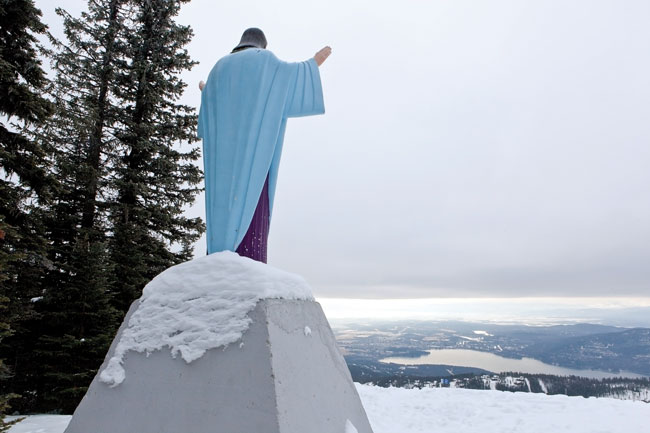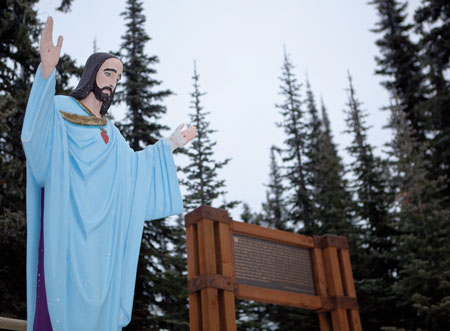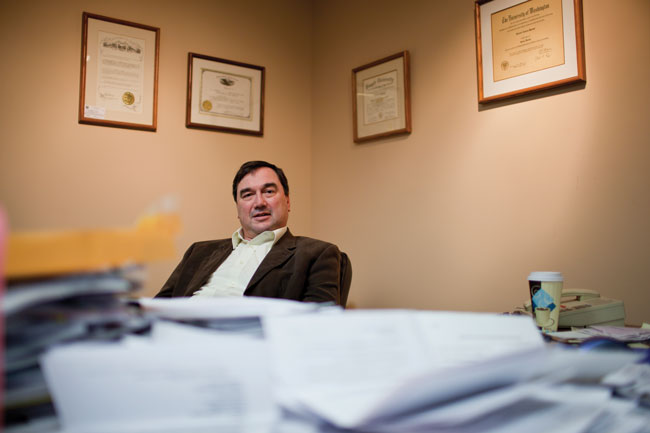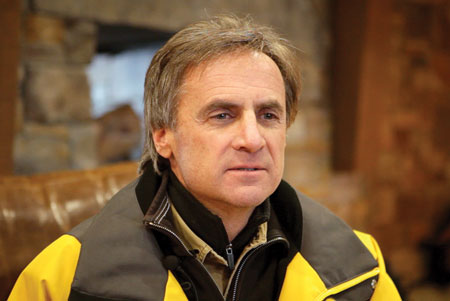 Big Mountain Jesus, a statue placed in 1954 to honor World War II veterans, has recently been challenged as unconstitutional. On an overcast day at the Whitefish Mountain Resort in northwestern Montana, a horizontal wall of clouds meets Big Mountain near the top of a chairlift, next to a life-size statue of Jesus. The statue stands with outstretched arms, blessing the Flathead Valley that spreads for miles below. A large question undergirds the debate on whether a religious statue in the middle of a Montana forest is legal or not: Should religion have a place in public life, or it is something to be kept private? Bill Glidden, an energetic man with gray hair and a white mustache, drove his red truck up the mountain toward the statue one recent morning. After retiring from Boeing and moving from Seattle to nearby Kalispell, Mont., Glidden became the grand knight of Kalispell Council 1328, which erected the statue in 1954 to honor the 10th Mountain Division’s service in World War II. He explained how his council responded to calls for the statue’s removal. When the council’s permit for the statue was denied its 10-year renewal in August 2011, the Wisconsin-based Freedom from Religion Foundation, took credit. In May, the group contacted the Forest Service for documents about the statue, arguing that the statue’s placement on federal land is unconstitutional. The group claims that the statue’s presence on federal land violates the First Amendment’s decree that the government may not establish a religion. The situation isn’t unique, as similar groups have leveled similar challenges over the past several years. One problem is that these situations hinge on constitutional issues that have been murkily or inconsistently treated by the U.S. Supreme Court and therefore give lower courts little to go on. A larger question, however, undergirds the debate on whether a religious statue in the middle of a Montana forest is legal or not: Should religion have a place in public life, or it is something to be kept private? Within months, what started as small-town Montana news became a national story. Glidden received letters from as far away as Iraq, where active-duty personnel asked about the situation. Before this, Glidden noted, the council was known for its charity. “But now we’re known for the statue,” he said.
A CLEAR CASE None of the Kalispel council’s current members were around when the statue was built in the 1950s, which makes the statue’s history difficult to tease out. Glidden could find just one person who remembered seeing Knights and veterans of the 10th Mountain Division at the statue’s dedication. Activated in 1943, the 10th Mountain Division was made of and by skiers, who secured a place in history by their bravery in World War II and by the ski runs they later carved into mountains across the country. The unit recruited world-class skiers from the National Ski Patrol, knowing that battles in rugged terrain would be a necessary part of the war in Europe. They trained in Washington, Colorado and West Virginia before landing in Italy to begin combat in January 1945. The division crisscrossed Italy, battling for four months until the war in Europe ended five months later.  Members of the 10th resettled across the United States, establishing some of the world’s best ski areas, including Aspen, Vail, Sugarbush, Crystal Mountain and Whitefish’s Big Mountain. The veterans in Whitefish arrived just as ski runs were being cut into Big Mountain and as two developers poured capital into a ski resort. The development paid off, and in 1949 and 1951, Big Mountain held the U.S. National Alpine Skiing Championships, which attracted thousands of spectators and hundreds of professional skiers, including far-flung members of the 10th Mountain Division. At the time, skiers asked why there wasn’t a shrine to commemorate the mountain — and the soldiers who fought in the 10th Division. Local members of the 10th, who were also Knights, thought to build a statue of Jesus, something akin to what they saw in the mountains throughout Europe. Locals say they came up with the idea while skiing. A group of Knights acquired a special-use permit from the Forest Service in 1953 to build a shrine near the top of the main ski run. A year later, the Knights dedicated the six-foot-one-inch statue of Jesus, which stands on a six-foot concrete base to lift it above the high snow. There, the cast-stone statue has sat for more than 50 years, mostly undisturbed. The Freedom from Religion Foundation’s complaints are nothing new. In 2009, the group spent more than $300,000 on litigation and complaints, about a quarter of its total expenses, according to tax filings. That same year, it fought seven lawsuits and placed more than 350 formal letters of complaint in places like Whitefish. The group claims 17,000 members nationwide and more than 100 in Montana. The reason the foundation can file and find success in such complaints, legal observers say, is because Establishment Clause rulings have been inconsistent and because governmental bodies can be bullied, forced to avoid litigation as budgets tighten due to the economy. This muddled state of the law exists, in part, thanks to seemingly contradictory court decisions. In October 2011, the U.S. Supreme Court decided not to hear a case about crosses on the side of a Utah highway. The lower court ruled that crosses erected in memory of fallen highway patrolmen were unconstitutional because they exhibited the police insignia and were on public land. Dissenting to the decision to not hear the case, Supreme Court Justice Clarence Thomas noted the inconsistency of Establishment Clause rulings: “A cross displayed on government property violates the Establishment Clause, as the Tenth Circuit held here, except when it doesn’t.” He added, “It is difficult to imagine an area of law more in need of clarity.” That same month, the 9th Circuit Court of Appeals decided that a large cross on public land north of San Diego, which served as a memorial for veterans, was unconstitutional. Circuit Court Judge Carlos T. Bea, joined by four other judges, disagreed with the decision to not rehear the case. He pointed out how crosses are a common military symbol — 114 Civil War monuments include a cross; Arlington Cemetery has three cross memorials; Gettysburg has two — and how numerous military branches use the cross as a symbol of distinguished service. There is significance, he wrote, in “the history behind these crosses and the simple fact that a cross has been used throughout this Nation’s history as a symbol of respect for veterans and fallen soldiers and their valor.” But the Whitefish case resides in a clearer area of public display law, according to Eric Rassbach, the national litigation director for the Becket Fund for Religious Liberty, a nonprofit law-firm and educational institute in Washington, D.C. It is clearer because the Knights leased the land, making the statue an example of private, not public, speech. “There’s nothing untoward about having private speech on privately controlled property,” Rassbach said. As such, the Knights, not the Forest Service, have always maintained the property on which the statue stands. In 1970, when the statue’s left arm was broken off and found near the chair lift, foresters sent a letter to the Knights instead of fixing the statue, alerting them of the issue and noting that their “effort to maintain a presentable area to the public is appreciated.”
 SOLVING THE PROBLEM SOLVING THE PROBLEMAfter the inquiry about the statue in May 2011, the Forest Service called a meeting with the Knights to find a solution. Glidden, along with Charles Harball, a Knight and attorney for the city of Kalispell, drove to the meeting together. In the Forest Service boardroom, Forest Service representatives sat on one side of a long conference table and Knights on the other. According to Harball and Glidden, the Forest Service was anxious to avoid litigation. “Their fix was that we need to move the statue,” Harball said. “We scratched our heads and asked, ‘Why do we need to move the statue?’” Little was decided that day. Two months later, the Forest Service denied the Knights’ permit, stating that the statue was an inappropriate use of public lands and that a plan for its removal must be submitted by Dec. 31, 2011. The Knights met in August to discuss the matter. “The consensus was that [the statue] is going to stay there — we can’t move it,” Glidden recalled. “We got some comments from professionals. One engineer said that we wouldn’t be able to move it; it would fall apart.” Harball and the council appealed the decision in September as news of the situation spread through national media. Meanwhile, the Forest Service’s local archeologist, Tim Light, sent a letter to the Montana State Historical Preservation Office one week after the permit denial, requesting comment on the situation. The letter acknowledged that the statue is religious and couldn’t be considered historic merely because of its association with veterans. Light argued, however, that the statue has strong, historical ties to the development of the ski area. The preservation office agreed, stating in a letter that it wasn’t a religious site because “unlike Lourdes or Fatima, people do not go there to pray, but it is a local landmark that skiers recognize, and it is a historic part of the resort.” Days after the Forest Service received this input, it revoked the permit’s denial and opened a public comment period on the grounds that the statue was a rare piece of local history from the 1950s. The Freedom From Religion Foundation, in a letter, called the decision “misguided,” claiming that the statue demonstrates the government’s preferential treatment to a religion and that calling the statue a war memorial is a “sham” because the original permit calls the statue a “shrine.” The letter urged that the Forest Service, for the betterment of taxpayers, remove the statue to eliminate the “need for costly and protracted litigation.” In the less than three months for comment, the public sent about 95,000 letters and email messages, according to Derek Milner, a project leader for the local Forest Service office. More than 40,000 people also visited a Facebook page titled “Save Big Mountain Jesus.” Through two-dozen interviews with people who live in and around Whitefish, it seems that people largely support the statue. Many see it as more of a landmark and less as a symbol that actively promotes Christianity. Katheryn Janetski, a local woman who has skied the mountain for years, views the statue as “part of our local heritage.” In December, Big Mountain still lacked enough snow to ski on some runs. “Maybe this has something to do with it,” Janetski said. Kyle Duty, a self-professed ski-bum who coaches the mountain’s snowboarding team, sees the statue as a landmark, and added that he could probably count the number of times he’d been to church on one hand. “Everybody in Whitefish, especially the people who live and ski here everyday, knows why the statue is there and that it is for those war heroes who lost their lives, that it’s not necessarily religious,” Duty said. “I mean, obviously it’s a statue of Jesus — but they’re not trying to preach Christianity to this town of Whitefish through this statue.” Dan Graves, president of the Whitefish Mountain Resort, was surprised with the situation. “I was a little outraged and I think many people were,” he said. “It seems like they are trying to take away not only a piece of history here on mountain and in Montana but also try to tell us how to live and what values we should or should not have.”  Graves stops by the statue on his daily rounds and listens to what people say about it. “I’ve never had any kind of complaint,” he said. He recently researched the statue’s history through local sources and had a plaque made to explain what a life-size statue of Jesus was doing at the top of a ski run. The plaque reads, in part, “A common memory from [the 10th Mountain Division’s] time in Italy and along the French and Swiss border was of the many religious shrines and statues in the mountain communities. … We thank those brave troops that brought this special shrine of Christ to the Big Mountain and hope that you enjoy and respect it.” If the permit is not approved, another group could sue the Forest Service to protect the statue. Harball’s opinion left little doubt of this possibility. “We’re not going to fold, say, ‘Gee, I think you might be right; maybe we don’t understand the Constitution.’ We think we understand the Constitution just fine.” One December morning after the end of the public comment period, Glidden and Harball met in Harball’s Kalispell office to talk about where the process with the statue has left them. Surrounded by bookshelves filled with legal volumes, Harball said, “Sometimes it seems that the whole world is going to hell in a handbasket, that we’re becoming completely secularized.” Still, Harball is grateful for the offers of help that he has received from numerous law firms and doesn’t plan on giving up soon. Glidden, also grateful for the support, recalled a packed evening at the Whitefish VFW lodge where the public gathered in November to voice their opinions. A veteran of 10th Mountain Division was there, as was U.S. Rep. Denny Rehberg, who stood up in Washington for the issue. Rehberg proposed a land-swap deal wherein the Forest Service land on which the statue stands would be traded for land that the resort owns. Glidden recalled a phone call he received a month earlier. The caller was a man from Chicago who identified himself as an atheist and wanted to share his feelings on the issue. He said that the debate wasn’t about Catholics or atheists — it was about war heroes. Glidden agreed. “Apparently he’d been out here and seen it. He skied, and thought it was a great thing for our veterans, and that’s what it’s all about.” While talking, Glidden’s phone rang twice, and he took the call. It was Kenneth Ellis, the grand knight of Whitefish Council 7630. The call was short, and Glidden soon flipped his phone shut, laughing. Ellis told Glidden that he received a call from woman who wanted to help keep the statue standing. Glidden takes these calls a lot. “The grand knight said this woman is leaving the valley and she wants to help us financially,” Glidden said. “Our response is thank you, but we’ll try to do this on our own.” |